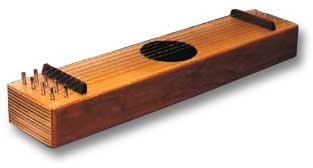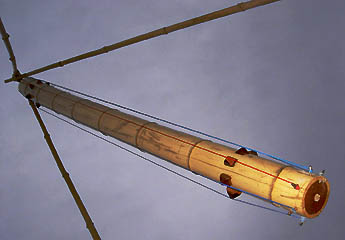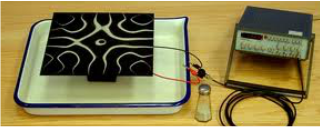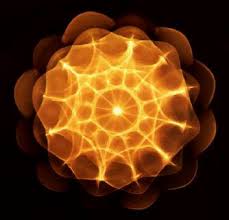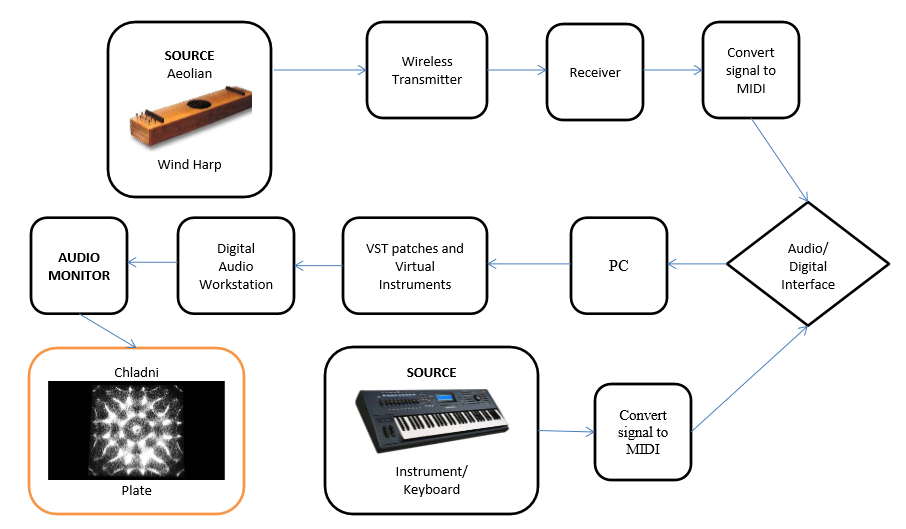Summary: an Aeolian Harp is connected via a radio transmitter to a Digital Audio Workstation. The acoustic energy of the harp, driven by the wind, is converted to a MIDI signal which is then used in the DAW to energize instrument patches. The sound of the harp can in this way be converted to, for example, a violin or a flute. The audio output may also be used to drive a Chladni plate (see below).
Detail: Wind energy stimulates the harp whose strings vibrate creating a quite unearthly sound. The vibrations are picked up by magnetic sensors which convert the signal to an electric current much as the pickups function on an electric guitar. The signal is then transmitted to a remote receiver, amplified, modified by the DAW and fed to a loudspeaker cone to which is attached the Chladni Plate. Fine grains or liquids on the plate resonate in sympathy with the sound vibrations creating corresponding kaleidoscopic patterns.
The sound can be modified via a Digital Audio Workstation and then mixed with a live or recorded accompaniment, created, for example, using a synthesiser. The whole system is described by the flow chart below. This is the experiment that is underway. The harp has potential for developing as a large scale sculpture.
Detail: Wind energy stimulates the harp whose strings vibrate creating a quite unearthly sound. The vibrations are picked up by magnetic sensors which convert the signal to an electric current much as the pickups function on an electric guitar. The signal is then transmitted to a remote receiver, amplified, modified by the DAW and fed to a loudspeaker cone to which is attached the Chladni Plate. Fine grains or liquids on the plate resonate in sympathy with the sound vibrations creating corresponding kaleidoscopic patterns.
The sound can be modified via a Digital Audio Workstation and then mixed with a live or recorded accompaniment, created, for example, using a synthesiser. The whole system is described by the flow chart below. This is the experiment that is underway. The harp has potential for developing as a large scale sculpture.
Aeolian Harp
Chladni Plate
One of Ernst Chladni's (1756 - 1827) best-known achievements was inventing a technique to show the various modes of vibration of a rigid surface. When resonating, a plate or membrane becomes divided into areas that vibrate freely, bounded by nodal lines where no vibration occurs.
Chladni repeated the pioneering experiments of Robert Hooke who, in 1680, had observed the nodal patterns associated with the vibrations of glass plates. Hooke ran a violin bow along the edge of a plate covered with flour and saw the nodal patterns emerge. |
Several strings under tension are stretched over two bridges, one at each end of a hollow box. The string tension can be altered to adjust their tuning. The strings vibrate in the wind at the frequencies (pitches) of the natural harmonic series.
The harp is subject to the von Karman vortex street effect: the motion of the wind across a string causes periodic vortices downwind and these alternating vortices make the string vibrate. When a musical instrument creates a note you hear its fundamental frequency coloured by other, lesser tones, called harmonics. The aeolian harp produces no fundamental, just the harmonics. It is this property that creates its weird sound. Sculpted Sound
The Heaven's Breath sculpture's sound source is the wind. Naturally generated acoustic energy from this source is modified and mixed with a synthesised sound source, fed to a Chladni plate and thus converted to visible music.
|
Flow Chart of the Complete System
Website by Weebly
